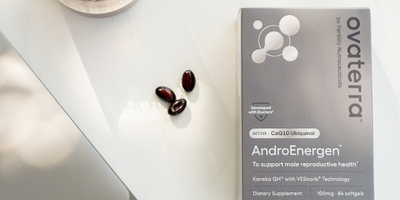Cervical fluid, or cervical mucus, is a key factor in women's chances of pregnancy. It helps sperm survive, move and fertilize the egg in the female reproductive tract. But can you do anything support fertile cervical fluid to maximize your chances of pregnancy? Yes, you can! Let's find out.
What is cervical fluid?
Cervical fluid is the fluid that is secreted by the cervix (the connecting organ between the vagina and the uterus). Cervical fluid plays a key role in facilitating a pregnancy when a woman is most fertile in each cycle.
Large proteins called mucins give cervical fluid a viscous consistency. Aside from mucins, cervical fluid contains water, proteins, enzymes, electrolytes and other compounds. The amount and composition of the cervical fluid changes throughout your menstrual cycle, which is a key factor in orchestrating a pregnancy.
Why is fertile cervical fluid or cervical mucus important for conception?
Cervical fluid is a necessity for reproductive success, because without fertile cervical fluid, sperm cannot survive and move in the female reproductive tract.
Five to six days around ovulation when you have a chance to conceive, the cervix secretes up to 30 times more cervical fluid than the rest of your menstrual cycle. During this fertile window, cervical fluid becomes “fertile” in multiple ways:
- To help the sperm swim through the female reproductive tract and eventually meet the just-ovulated egg for fertilization, cervical fluid becomes more watery and slippery in consistency.
- Fertile cervical mucus is also more alkaline (basic), which is friendlier to sperm’s survival than the acidic cervical fluid in the rest of your menstrual cycle.
- Cervical fluid contains a range of nutrients and compounds that help the sperm thrive, including glucose and amino acids, as well as trace elements like zinc, copper and selenium, many of which have been suggested as key to sperm health.
All of these changes in cervical fluid helps sperm enter the uterus and move into the fallopian tube, where it can meet the mature egg and fertilize it.
About 24-36 hours after ovulation, the fertile window closes – meaning that the ovulated egg has died without fertilization, and there is no opportunity for a pregnancy until next ovulation. After the fertile window closes, cervical fluid becomes thicker and more viscous or almost non-existent, which helps keep out pathogens (and sperm) from entering the uterus.
What makes cervical fluid fertile?
The consistency of cervical fluid is largely controlled by several reproductive hormones. Estrogen levels rise toward ovulation, from the low levels at the beginning of your menstrual cycle. This rise in estrogen stimulates the glands (endocervical glands) in the cervix to secrete fertile cervical mucus.
As ovulation approaches, estrogen levels go back down and another reproductive hormone – progesterone – rises, giving the endometrial lining of the uterus to get ready for potential implantation. With this shift in hormonal balance, cervical fluid production slows in the second half of your menstrual cycle (called the luteal phase).
What does fertile cervical fluid look and feel like?
Fertile cervical fluid is abundant, watery, slippery, stretchy and mostly transparent. “Like the raw egg whites” is one of the most common ways to describe the fertile cervical fluid.
It looks and feels quite different from the thick, sticky and opaque cervical fluid of the rest of your menstrual cycle. The appearance and texture are distinct enough that many women can detect fairly reliably when they are most fertile in each menstrual cycle. This is called the cervical mucus method of ovulation tracking.
While we can’t see it, the composition of fertile cervical fluid is also distinct. kegg Fertility Tracker, one of the most advanced, digital ovulation trackers on the market, uses these changes in chemical composition to accurately identify a woman’s fertile window.
How to support fertile cervical fluid
Water accounts for over 90% of the cervical fluid. During your fertile window, it can be up to 98% water. So it goes without saying that staying hydrated is an important part of supporting fertile cervical fluid. To stay hydrated:
- Drink plenty of water;
- Eat more fruits and vegetables; and
- Avoid medications that can worsen dehydration, like antihistamines, when possible.
Keeping your cervix and surrounding organs healthy is also important.
- Keeping inflammation at bay can help the cervix secrete the right amount of cervical mucus.
- Healthy vaginal microbiome, the ecosystem of the bacteria and fungi in the vagina, can help keep the vagina and cervix in a healthy state for reproductive health. If you are unsure about your vaginal microbiome, a discreet at-home test for vaginal microbiome like Evvy might be a good option.
- Many lubricants and douches can harm beneficial bacteria and cause an imbalance of vaginal microbiome, potentially impacting the amount and quality of cervical fluid.
This goes beyond the health of your cervical fluid, but it’s closely related and important: Make sure the lubricant you use don’t harm the sperm.
- Many lubricants can also kill sperm or hamper its ability to move. If you need lubricants, make sure to choose a brand that’s made with non-spermicidal ingredients. Here’s a lit of lubricants approved by FDA as fertility-friendly.
Improving cervical fluid – what’s not supported by science
You may see some diet- or supplement-focused recommendations to “improve” your cervical fluid and increase your chances of pregnancy. Some common recommendations include grapefruits, evening primrose oil, L-arginine, dandelion and more. Most of these don’t have a strong basis in science, so it’s best to check with your doctor if you are thinking about giving them a try.
Please reach out if any questions come up about the cervical mucus’ role in facilitating a pregnancy, and how you can support its health. We are with you.
Ovaterra provides reproductive health resources for general, educational purposes only. This content is not intended to replace medical advice from a qualified healthcare professional. Similarly, when making your financial decisions, please consult qualified financial professionals who can make individual recommendations.














